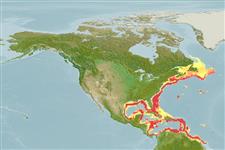>
Gadiformes (Cods) >
Moridae (Morid cods)
Etymology: Laemonema: Greek, laimos = throat + Greek, nema = filament (Ref. 45335).
More on authors: Goode & Bean.
Environment: milieu / climate zone / depth range / distribution range
Ökologie
seewasser benthopelagisch; tiefenbereich 50 - 1620 m (Ref. 31160). Subtropical; 57°N - 4°N, 98°W - 43°W
Western Atlantic: Canada to French Guiana.
Size / Gewicht / Alter
Maturity: Lm ? range ? - ? cm
Max length : 33.0 cm SL Männchen/unbestimmt; (Ref. 5951)
Rückenflossenstacheln (insgesamt): 0; Rückenflossenweichstrahlen (insgesamt): 69-76; Afterflossenstacheln 0; Afterflossenweichstrahlen: 57 - 63. Body low and slender with small deciduous scales (Ref. 31160). Upper jaw reaching below middle of eye; teeth on jaws forming a band, outer series enlarged; first dorsal fin ray produced; anterior part of anal fin elevated; no distinct blackish mark on posterior end of dorsal and anal fins (Ref. 13608) - last phrase conflicting with Ref. 31160.
Life cycle and mating behavior
Geschlechtsreife | Fortpflanzung | Ablaichen | Eier | Fecundity | Larven
Meléndez, C., R. and D.F. Markle, 1997. Phylogeny and zoogeography of Laemonema and Guttigadus (Pisces: Gadiformes: Moridae). Bull. Mar. Sci. 61(3):593-670. (Ref. 31160)
IUCN Rote Liste Status (Ref. 130435)
Bedrohung für Menschen
Harmless
Nutzung durch Menschen
Mehr Information
NamenSynonymeMetabolismusRäuberÖkotoxikologieFortpflanzungGeschlechtsreifeAblaichenSpawning aggregationFecundityEierEientwicklung
ReferenzenAquakulturAquakultur ProfilZuchtlinienGenetikElectrophoresesVererbbarkeitKrankheitenVerarbeitungNutrientsMass conversion
PartnerBilderStamps, Coins Misc.LauteCiguateraGeschwindigkeitSchwimmstilKiemenoberflächeOtolithsGehirngrößeSehfähigkeit
Tools
Zusatzinformationen
Download XML
Internet Quellen
Estimates based on models
Preferred temperature (Ref.
123201): 4.5 - 16.9, mean 10.5 °C (based on 224 cells).
Phylogenetic diversity index (Ref.
82804): PD
50 = 0.5000 [Uniqueness, from 0.5 = low to 2.0 = high].
Bayesian length-weight: a=0.00363 (0.00215 - 0.00613), b=3.14 (2.99 - 3.29), in cm total length, based on LWR estimates for this species & (Sub)family-body (Ref.
93245).
Trophic level (Ref.
69278): 3.5 ±0.5 se; based on size and trophs of closest relatives
Widerstandsfähigkeit (Ref.
120179): niedrig, Verdopplung der Population dauert 4,5 - 14 Jahre. (Preliminary K or Fecundity.).
Fishing Vulnerability (Ref.
59153): Low to moderate vulnerability (30 of 100).
